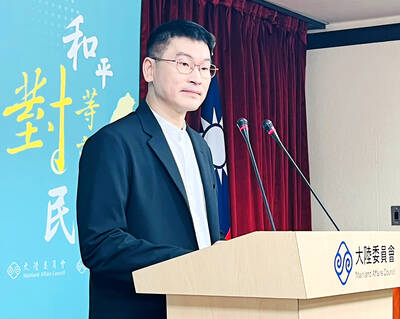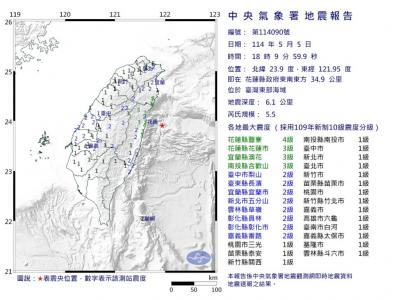If China significantly reduces the number of missiles it aims at Taiwan — a move that was hinted at last week by Chinese Premier Minister Wen Jiabao (溫家寶), though without any timeframe — the US can be expected to cut arms sales to Taiwan, a Washington conference was told on Tuesday.
“It just makes sense: If the military threat was reduced, of course it would have an effect on arms sales,” said former Pentagon official Mark Stokes, executive director of the Project 2049 Institute.
In one of the first public discussions on the subject by US experts gathered at the conservative Heritage Foundation, Stokes said the best move China could make to stabilize the situation in the Taiwan Strait would be to renounce the use of force as a means to resolve differences with Taiwan.
Stokes said that at a minimum, the five missile brigades now facing Taiwan should be moved back or, preferably, redeployed far from the Strait.
However, he said it was imperative that the “entire infrastructure” supporting the brigades should be moved with them.
This development would decrease the Chinese threat to Taiwan, Stokes said, adding that Taiwan faced the most stressful and most significant “military challenge in the world.”
“It would have a significant operational effect on [China’s] ability to carry out military -operations,” Stokes said.
Although there was no way to be sure if Beijing would ever order the missiles to be moved, Stokes said, they might try to give the appearance of reducing the threat by destroying some of the older missiles and claiming to retarget others.
It would not be appropriate or viable for the US to negotiate with China over arms sale to Taiwan, but if Beijing reduced its military threat, it would make “all the sense in the world to reassess Taiwan’s military requirements,” Stokes said.
None of the other experts present disagreed with him.
Dean Cheng (成斌), a research fellow at the Heritage Foundation’s Asian Studies Center, said the problem with redeploying missiles was finding a place to put them.
No matter where the five -missile brigades and their infrastructure were sent — closer to South Korea, Japan, India or Russia — “you are going to have some extremely antagonized neighbors,” he said.
Asked by journalists in New York on Sept. 22 about the possibility of China removing some of the about 1,500 missiles aimed at Taiwan, Wen said that the Economic Cooperation Framework Agreement (ECFA) provided a foundation for talks on issues, including military confidence building.
“I believe that [removal] will eventually happen,” the premier said, without providing any context or timeline.
There has since been speculation in circles close to US President Barack Obama’s administration about how the US would react, and if the subject would be raised during two days of talks this week in Beijing by US Deputy Assistant Secretary of Defense for East Asia Michael Schiffer.
Schiffer was in China to lay the groundwork for renewed high-level military-to-military contacts with the US, which were suspended in January to protest Washington’s decision to sell US$6.4 billion in arms to Taiwan.
Writing in the Washington Post this week, Robert Kaplan, senior fellow at the Center for a New American Security, said: “We underestimate the importance of what is occurring between China and Taiwan.
“With 270 flights per week between the countries, and hundreds of missiles on the mainland targeting the island, China is quietly incorporating Taiwan into its dominion,” he wrote.
“Once it becomes clear, a few years or a decade hence, that the US cannot credibly defend Taiwan, China will be able to redirect its naval energies beyond the first island chain in the Pacific to the second island chain and in the opposite direction, to the Indian Ocean,” he said.

An essay competition jointly organized by a local writing society and a publisher affiliated with the Chinese Communist Party (CCP) might have contravened the Act Governing Relations Between the People of the Taiwan Area and the Mainland Area (臺灣地區與大陸地區人民關係條例), the Mainland Affairs Council (MAC) said on Thursday. “In this case, the partner organization is clearly an agency under the CCP’s Fujian Provincial Committee,” MAC Deputy Minister and spokesperson Liang Wen-chieh (梁文傑) said at a news briefing in Taipei. “It also involves bringing Taiwanese students to China with all-expenses-paid arrangements to attend award ceremonies and camps,” Liang said. Those two “characteristics” are typically sufficient

A magnitude 5.9 earthquake that struck about 33km off the coast of Hualien City was the "main shock" in a series of quakes in the area, with aftershocks expected over the next three days, the Central Weather Administration (CWA) said yesterday. Prior to the magnitude 5.9 quake shaking most of Taiwan at 6:53pm yesterday, six other earthquakes stronger than a magnitude of 4, starting with a magnitude 5.5 quake at 6:09pm, occurred in the area. CWA Seismological Center Director Wu Chien-fu (吳健富) confirmed that the quakes were all part of the same series and that the magnitude 5.5 temblor was

The brilliant blue waters, thick foliage and bucolic atmosphere on this seemingly idyllic archipelago deep in the Pacific Ocean belie the key role it now plays in a titanic geopolitical struggle. Palau is again on the front line as China, and the US and its allies prepare their forces in an intensifying contest for control over the Asia-Pacific region. The democratic nation of just 17,000 people hosts US-controlled airstrips and soon-to-be-completed radar installations that the US military describes as “critical” to monitoring vast swathes of water and airspace. It is also a key piece of the second island chain, a string of

The Central Weather Administration has issued a heat alert for southeastern Taiwan, warning of temperatures as high as 36°C today, while alerting some coastal areas of strong winds later in the day. Kaohsiung’s Neimen District (內門) and Pingtung County’s Neipu Township (內埔) are under an orange heat alert, which warns of temperatures as high as 36°C for three consecutive days, the CWA said, citing southwest winds. The heat would also extend to Tainan’s Nansi (楠西) and Yujing (玉井) districts, as well as Pingtung’s Gaoshu (高樹), Yanpu (鹽埔) and Majia (瑪家) townships, it said, forecasting highs of up to 36°C in those areas